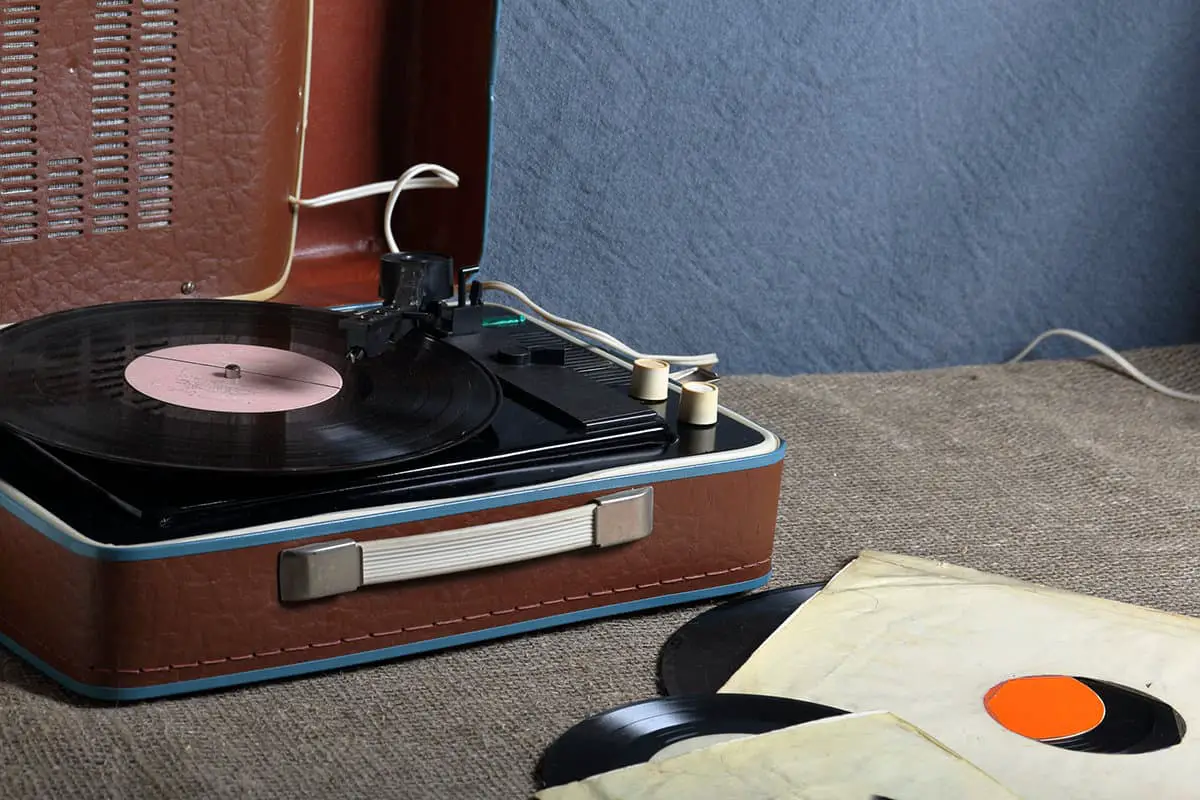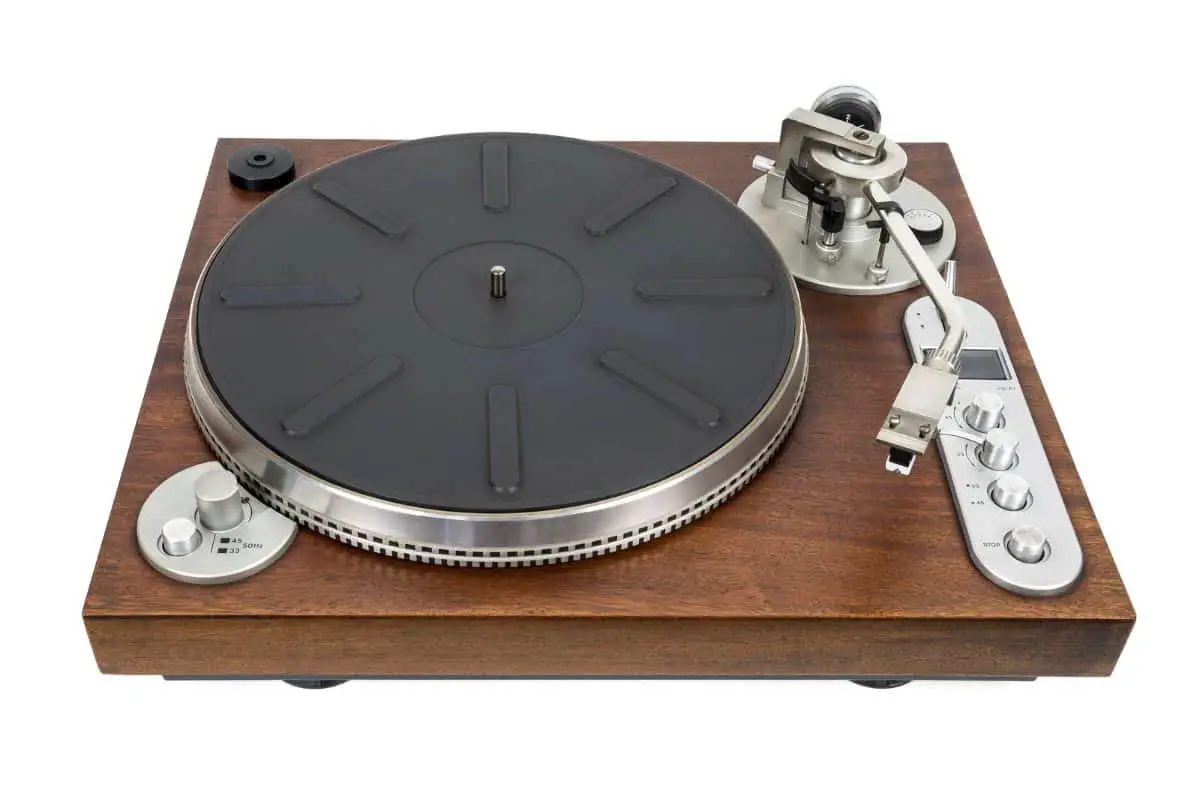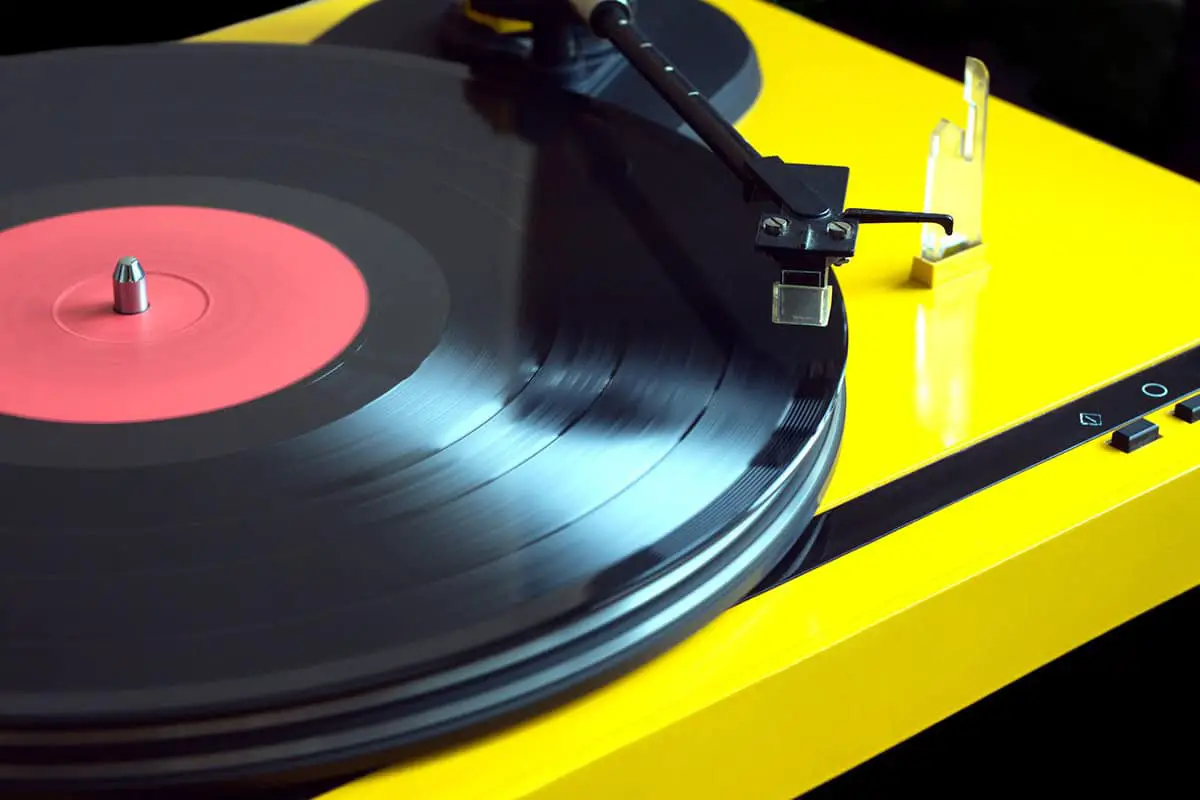This post contains affiliate links.

Has your record player suddenly gone quiet, and you’re looking for ways to solve the problem? Then you’re in the right place. This article discusses all the possible reasons why your record player is quiet and the best ways to get the volume back up.
The most common culprit behind a record player suddenly going quiet is the cartridge. However, several faults can arise and cause your record player to go silent. The good news is that it is easy to fix all of these faults.
Record players, by nature, are not designed to give out the sound with the volume you would get from your regular TV or CD player.
Record players instead produce a super low electrical signal produced by the movement of the stylus on the groove.
These electrical signals need double amplification. It is where the preamplifier and the amplifier come in.
The preamplifier reads these signals and changes them into a LINE. The amplifier then reads this LINE signal and then transmits it aloud as the sound or music we enjoy.
If you follow the instructions in the record player’s manual to the detail and set it up correctly, then your record player should not be quiet. If you are experiencing sound issues with your record player, there might be other reasons for low sound or sound loss.
Table of Contents
The Most Common Reasons Why Your Record Player Is Silent
Let’s go over some of the possible reasons for a quiet record player and how to solve these issues.
1. Cartridge Problems
A record player cartridge is also known as a phonograph cartridge, and this component houses the stylus that reads the sound from the record’s groove.
The cartridge identifies the sound patterns and runs through the grooves to produce quality musical notes.
There are two variations of a record player’s cartridge.
They are known as the
- Moving Magnet Cartridges (MM)
- Moving Coil Cartridges (MC)
Standard or lower-end turntables, in most instances, come with a Moving Magnet cartridge. At the same time, the higher-end record players are populated by Moving Coil cartridges.
It goes without saying that if you are not a vinyl record lover with a costly record player, you quite possibly own a record player with a Moving Magnet cartridge.
Record-loving fans prefer the record players with Moving Coil cartridges is because MC cartridges have a lower mass that allows them to read the grooves in the record with more precision, speed, and accuracy. It, in turn, results in better reproduction of the recorded sound.
On the other hand, the MC cartridges are known to produce a much weaker Phono signal than the premium MM cartridges. It is why they are primarily found in lesser record player models.
Differences between both cartridges are shown in the table below.
|
Cartridge Type |
Phono Output |
|---|---|
|
Moving Magnet (MM) |
5mV ( range is between 2mV – 8mV) |
|
Moving Coil (MC) |
0.5mV (range is between 0.2mV – 1.5mV) |
The PHONO signal released from an MC cartridge is typically weaker than the PHONO signal emitted from a MM cartridge.
By default, the MC PHONO signal will need more amplification than a MM PHONO signal to reach the standard LINE signal level of 0.316 Volt.
When purchasing an external preamp, it is vital to check that it supports the cartridge type you use. Some high-output type MC cartridges produce nearly the same signal level as a MM cartridge.
2. Cheap Quality Record Player
The quality of sound your record player will produce depends on the quality of the record player itself. A cheap quality record player will not give you the same sound quality as a high-end record player.
Although high-quality players might seem costly, they are worth investing in in the long run. These record players will last much longer than the cheap ones and will hardly give you difficulties.
3. Needle Problems
The stylus is a pretty essential component of the turntable. It is a tiny dot that rests on the groove, thereby reading and producing sound.
The stylus is bound to lose its texture after a long period of continuous usage. However, the needle can wear out before its time due to dust accumulation.
Although needles are made up of solid materials, they can be affected when dust particles stick to them during the usage period.
Non-stop contact with dust will wear out the needle and make your record sound quieter over time. Excessive use can also cause the stylus to lose its sturdy grip.
4. Bad RCA Cables
It is quite a common occurrence. Many of these cables are cheap and poorly designed, so much so that the soldered connections at the tips eventually break loose due to bending and a few hours of usage.
You can tell your RCA cable is bad by using a multimeter. Once you notice they’re bad or worn out, try to replace your RCA cables with some quality ones. (Source)
5. Speaker Problems
Speakers are responsible for providing us with a good sound, and they come with a remote controller to easily control and adjust the volume.
There are two main types of speakers, the cable speaker that is directly connected to the record player and the Bluetooth speakers that can be connected using a remote control. Most people prefer the second option due to the fast and easy connection and a long time usage guarantee.
Cheap speakers can wear out very quickly. A quick way to find out if you are experiencing speaker problems is to connect your record player to a different speaker. If the problem continues, then you are sure your speaker is yet to wear out.
6. Tonearm Problems
A tonearm is a long arm that supports the cartridge to run smoothly and stop the record disc. It houses the cartridge and stylus and maintains the perfect angle and height with accurate pressure to process its function.
It is an essential component of a record player and most times houses the most problems. Some of the issues that you may experience with tonearms include:
- Tonearm swinging to the side – This issue can arise if your record player is not on a level surface or the balance is off with the arm. Most of the tonearms are incredibly delicate and, as such, need to be handled carefully in the correct manner.
- The tonearm is not lowering – You should notice that the tonearm is not making direct contact with the disc and causing some skips while playing the record. It can be down to the tonearms bridge screw being screwed down too tightly or too loose. A simple adjustment to this bridge screw should fix the problem.
7. Wrong/Incorrect Wiring
It is not at all uncommon for a record player newbie to experience wrong wiring or output connections. However, a few boxes need to be checked before you can conclude or determine if you got your external wiring wrong.
8. Absence Of A Phono Preamp
Every record player needs a preamplifier. It can be a built-in internal preamplifier or a separate external preamplifier. You can also use the preamplifier on your receiver, which you can find in the phono input section.
To produce clear and quality sound, it is imperative to determine which preamp your player utilizes and use just that.
Changes might lead to sound distortions. If your record player does not have a built-in preamplifier, you can purchase an external preamp or use the preamp on your receiver. Qualities to look out for when buying an external preamp include:
9. Non-operational Internal Preamp
For record player models that come with a built-in preamp run a check to confirm your record player’s inbuilt preamplifier is on. You should find an on and off switch for this simple command.
If your record player’s internal preamp is on, do not connect your record player into the phono input on your receiver that would result in you using the preamp on the receiver simultaneously. Using both preamps will result in terrible sound distortion and quality.
10. Record Player Plugged Into The Wrong Phono Input On The Receiver
Most audio receivers have a phono input. It is an analog input that is made just for record players. It houses an internal preamplifier that transmits the electronic signal to a line-level which can then be amplified to the speakers.
On the other hand, a line signal is the standard audio output level that most audio devices use as an industry standard.
Devices such as CD players, laptops, mobile phones, and TVs will produce a line signal without any changes or amplification of the signal.
Line signals are more substantial than phono signals, being amplified to an industry-standard voltage. While a phono signal is 0.005 of a millivolt, a line signal is 0.316 volts root-mean-square.
The audio recordings produced from these devices show a much higher electrical signal, and as such, they do not require extra amplification.
By default, when you plug a device into the line input, it will easily play the sound without changing or amplifying the electrical signals.
Differences between line and phono signals are shown in the table below:
|
Line |
Phono |
|---|---|
|
Weak Signal 0.3 Volt |
Weaker Signal 0.005 Volt |
|
Boosted Bass (RIAA equalized) |
Flat Frequency Curve |
Record player owners should pay attention to these differences because the variations strongly affect the production of sound.
You should plug the RCA jacks into the correct phono input for quality sound production if your receiver houses an analog input. It is not uncommon to randomly plug in your record player’s jack into any input on your receiver.
However, it is essential to note that they do not serve the same functions. So always make sure you have plugged in the jack correctly for excellent sound production.
Difference Between The Line Output And The Line Input
Displayed behind your turntable or other audio playing device multiple times, you may find the word “line.” While one of the labels may be just beside the word”phono,” other labels might read “line-in” or “line output.”
It, however, does not mean they are related to line signals entirely.
The line input port close to the phono input port is meant to plug in the audio device cable.
The line-in labeled port is designed to assist with maintaining audio quality while recording.
The line output jack is where you can plug in an external amplification cable. It could be a PA system, headphones, or home theaters.
11. Cheap/Worn Out Record
Cheap records poorly made might be a contributing factor to low sounds. Excessive play of a particular record, too, might result in scratches and wears. It can lead to poor or low sound production by the record player due to its inability to correctly read the record.
How to Make Your Record Player Louder

We have outlined some of the problems you might be experiencing that would cause your record player to be quiet or produce low sounds. Now let’s talk about how to make your record player loud again with a few helpful tips.
Replacing the Cartridge
A faulty or worn-out cartridge is one of the problems to be considered when the volume of the sound produced suddenly goes down. If you have used the cartridge for quite some time, it is possible that the needle has gathered dust or has other defects like scratches and this, in turn, affects its output.
Run a check through the surface of the cartridge to make sure that you are not replacing a fully functional component.
A second method to fix the cartridge issue is to replace the cartridge with an output level that is double its current output level. It is conducive to increasing the sound quality and producing a much louder sound. (Source)
Change The Amplifier
It costs a lot of money to change an amplifier, so you want to be sure the fault is from the amplifier before you decide to make such a pricey investment. Once you have confirmed the preamplifier and the cartridge are not the problems, you can consider changing the amplifier.
The amplifier can be described as the final stage of the record player as it re-equalizes the electronic signal converted by the preamplifier and then amplifies the sound.
You can make the switch to a more powerful version after confirming the current one is faulty so that you can enjoy a much louder and more refined sound. You can / should also seek professional help before making such a decision.
Use High-Sensitivity Speakers
A speaker’s sensitivity is the volume of music a speaker can deliver when a specific power (Watts) passes through it. A higher sensitivity means that most of the power sent to it is converted into sound.
As opposed to a speaker with lower sensitivity that converts all its energy into heat, which is pretty much not useful. (Source)
Sound sensitivity is an essential factor to consider when experiencing any sound complaints. Sound sensitivity is also necessary with loudspeakers and home theatres, not just with your record players but generally with your sound electronics.
Install A Phono Preamp
The function of the phono preamp is to receive the signal sent by the stylus and translate it into a LINE, and it also pre amplifies the sound produced by the record player.
The sound produced by a record player is nothing compared to the sound produced by a CD player or your Home Theater. The quality of sound produced by a record player without using a preamplifier will be low or non-existent. (Source)
If your record player already has an inbuilt phono preamp, but you would still want a louder voice, the next step you should consider would be updating the existing preamp with a higher output level.
A phono preamp with a higher gain will positively affect the quality of the sound produced. The updated preamp will use advanced technology to filter out songs in a better manner, thereby making them super clear and loud. (Source)
There are two types of phonograph preamp, the kind that comes already pre-installed in your record player and the external type that can be attached using external cords.
For built-in record player preamps, mostly its output and gain level are always relatively low. Ensure the external preamp you purchased is of higher quality than what you already have to avoid further damages or complications.
Conclusion
Record players are sensitive items that require proper care and utmost careful maintenance to continue working perfectly.
There are several reasons for a record player to experience volume issues. We have extensively talked about several reasons that could be responsible for low sound production or sound loss and how to solve these problems.
Hopefully, after reading this article, you can troubleshoot and identify the issue with your record player and get it fixed.
Reaching out to an expert for professional help if you realize your record player requires more attention or diagnosis than explained is a great idea. You can also visit your record store for advice or to seek clarity.
Poor or low sound production is not a good enough reason to discard your record player. There are several repair options and hacks to leave it feeling brand new again.
Source
- Hand Tools For Fun, “How To Test RCA Cables with A Multimeter,” Hand Tools For Fun, Accessed November 18, 2021, https://handtoolsforfun.com/how-to-test-rca-cables-with-a-multimeter/
- Crutchfield, “How to Replace Your Phono Cartridge,” YouTube Video 9:14, Posted By “Crutchfield,” March 18, 2020, https://www.youtube.com/watch?v=1J_kI2hhV5A
- Gary Altunian, “What Is a Speaker Efficiency or Sensitivity Rating?”, LifeWire, Accessed November 18, 2021, https://www.lifewire.com/amp-power-speaker-efficiency-3135077
- The Next Web, “Does your record player need an external phono preamp?” The Next Web, Published July 8, 2021, Accessed November 18, 2021, https://thenextweb.com/news/does-record-player-turntable-need-external-phono-preamp-stage
- Julian Krause, “USE YOUR GAIN! The TRUTH about maximum gain setting (set preamp gain properly and minimize noise),” YouTube Video 11:25, Posted by “Julian Krause,” August 6, 2020, https://www.youtube.com/watch?v=beXVfl1TSD0
VacationVinyl.com is a participant in the Amazon Services LLC Associates Program, an affiliate advertising program designed to provide a means for sites to earn advertising fees by advertising and linking to Amazon.com. We also participate in other affiliate programs which compensate us for referring traffic.



